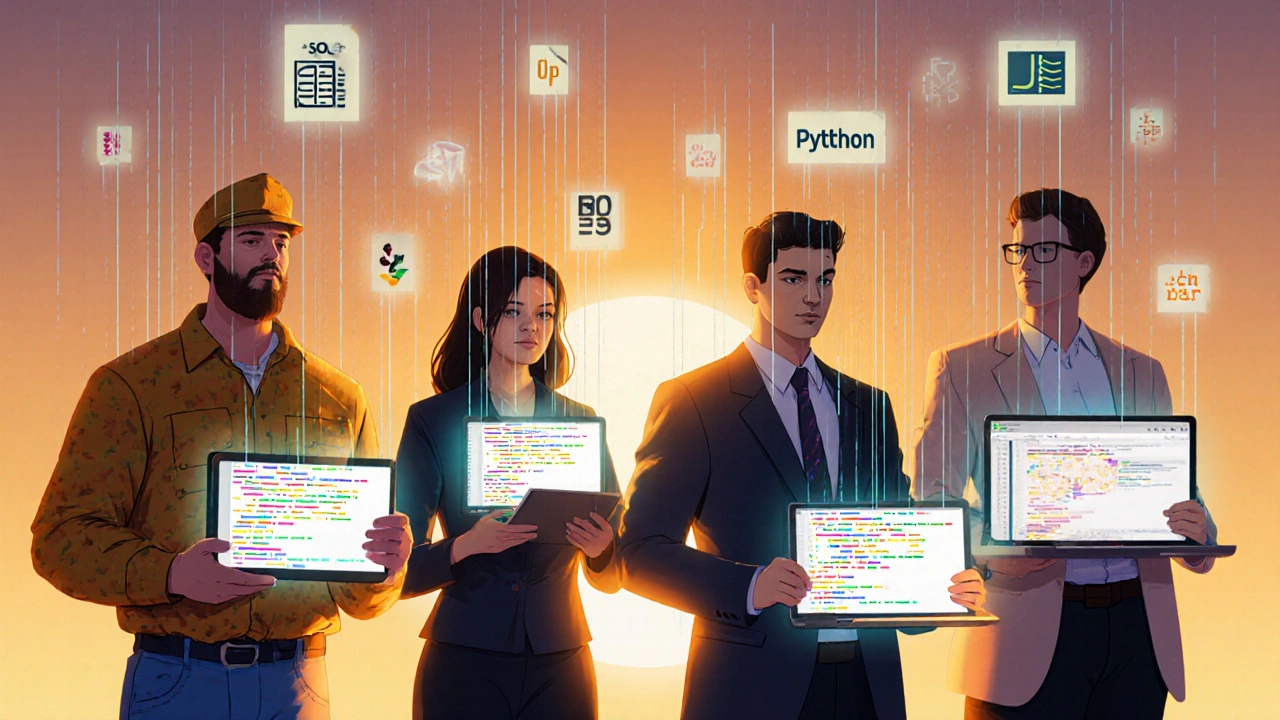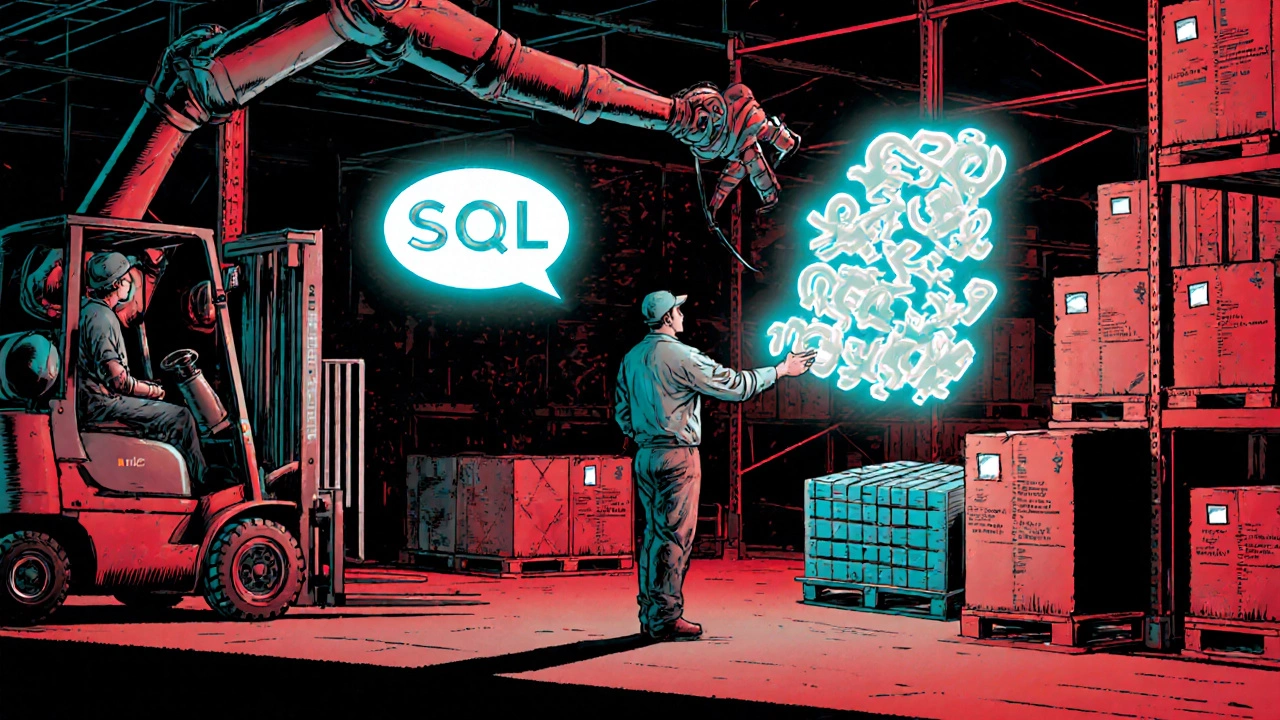Think coding is only for software engineers? That’s a myth. Coding isn’t just for people in hoodies typing away in Silicon Valley. It’s in hospitals, banks, museums, farms, and even movie studios. If you’ve ever used an app, clicked a button online, or seen a weather forecast, someone wrote code to make that happen. And the people writing it? They’re not all computer science grads. Many come from totally different backgrounds.
Healthcare: Code That Saves Lives
Hospitals don’t run on clipboards anymore. Electronic health records, MRI machines, and patient monitoring systems all run on custom software. Medical coders translate diagnoses and procedures into standardized codes so insurance claims process correctly. That’s not just typing-it’s logic. A single wrong code can delay payment or even deny care.
Biomedical engineers write code to control robotic surgery tools. Researchers use Python to analyze DNA sequences. Even nurses use simple scripts to automate patient alerts or track medication schedules. You don’t need a PhD to do this. Many start with online courses in Python or SQL, then learn on the job.
Finance: Where Numbers Meet Logic
Banks don’t hire coders just to build apps. They hire them to catch fraud. Algorithms scan millions of transactions every minute, looking for patterns that look suspicious. A $5,000 charge in Paris right after a $200 purchase in Texas? That’s code flagging it before the bank even knows.
Quantitative analysts-often called “quants”-use R and MATLAB to model market risks. Traders write scripts to auto-execute trades based on price changes. Even accountants use Excel macros to clean up spreadsheets that used to take days. You don’t need to build the next TikTok. You just need to make sure a spreadsheet doesn’t crash during tax season.
Marketing and E-Commerce: Personalization Is Code
When Amazon recommends a book you didn’t know you wanted, that’s code. When your favorite brand sends you a discount email exactly when you’re browsing their site, that’s code too. Digital marketers use JavaScript to track user behavior. They use SQL to pull data from customer databases. They use Python to test which email subject lines get more opens.
Even small online stores use Shopify plugins built with Liquid, a simple templating language. You don’t need to be a developer to use them-but knowing how they work lets you fix broken buttons, speed up checkout, or customize product pages without waiting for IT. That’s a huge edge if you run your own shop.
Media and Entertainment: Behind the Scenes
Ever wonder how Netflix knows what to show you next? Or how CGI characters in movies move so naturally? That’s code. Video editors use scripts to automate color grading across hundreds of clips. Sound engineers write code to remove background noise in real time. Game developers use C# and Unity to build interactive experiences.
Even journalists use coding. Data journalists scrape public records, analyze crime stats, and turn spreadsheets into interactive maps. The Washington Post used Python to analyze police bodycam footage during protests. You don’t need to be a programmer to do this-you need curiosity and a willingness to learn a few tools.

Manufacturing and Logistics: Code That Moves the World
Factories don’t run on muscle anymore. Robots assemble cars, sort packages, and load shipping containers. Those robots follow instructions written in ladder logic, Python, or C++. Warehouse managers use code to optimize storage layouts and predict when inventory will run low.
Even farmers use coding. Sensors in the soil send data to apps that tell them exactly when to water crops. Drones with custom software scan fields for pests. A farmer in Iowa might not call themselves a coder, but they’re using code to save time and increase yield.
Education and Nonprofits: Teaching Through Tech
Schools use learning management systems like Moodle or Google Classroom-both built with code. Teachers who know how to tweak these tools can automate grading, track student progress, or create interactive quizzes. Nonprofits use code to manage donations, map service areas, or send SMS reminders to patients in rural clinics.
Organizations like Code for America train volunteers to build simple apps that help people access food stamps or housing aid. You don’t need to work at Google. You just need to care about a problem-and know how to write a few lines of code to fix it.
Design and Architecture: Visuals Powered by Logic
Graphic designers use Adobe Illustrator, but many also use scripting to automate repetitive tasks. Want to resize 500 logos for different platforms? A JavaScript script can do it in seconds. Architects use Rhino and Grasshopper, which rely on visual programming to generate complex building shapes.
Interior designers use code to simulate lighting in a room before they buy furniture. Fashion designers use 3D modeling tools to create digital prototypes, cutting down on fabric waste. These aren’t tech jobs-they’re creative jobs that got better with code.

Government and Public Services: Code for the People
City governments use code to track traffic patterns, predict potholes, and manage public transit. When you use a bus app to see when your ride is coming, that’s code connecting real-time GPS data to your phone.
Police departments use algorithms to allocate patrol cars. Environmental agencies use code to model air quality. Even libraries use databases to track book checkouts and recommend titles. You don’t need to be a hacker to work in public service-you just need to understand how data flows.
What Skills Do You Actually Need?
You don’t need to learn every programming language. Most jobs don’t ask for that. Here’s what actually matters:
- Python: Easy to learn, used everywhere-from finance to biology.
- SQL: For pulling data from databases. Essential in marketing, healthcare, and government.
- JavaScript: For web tools, forms, and tracking. Used in e-commerce and education.
- Excel formulas and macros: Still the #1 tool in offices. Learning VBA (Visual Basic for Applications) gives you superpowers.
- Basic scripting: Automating files, renaming batches, moving data. Takes 2 hours to learn, saves 20 hours a week.
Most people start with free resources: Codecademy, freeCodeCamp, or YouTube tutorials. You can build a real skill in 3-6 months without spending a dime.
Can You Get a Job Without a Degree?
Yes. And it’s happening every day.
A customer service rep in Ohio learned Python to automate ticket responses. Now she’s a data analyst. A high school teacher in Texas used Excel macros to grade essays faster. She now trains other teachers in tech tools. A warehouse worker in Texas took an online SQL course and moved into inventory management.
Employers care more about what you can do than where you went to school. A portfolio of small projects-a script that organizes photos, a dashboard that tracks your spending, a bot that sends birthday emails-is worth more than a resume with a degree but no examples.
Where to Start Today
Don’t wait for the perfect time. Start with one small goal:
- Pick one task you do weekly that feels boring or repetitive.
- Search “how to automate [task] with Python” or “Excel macro for [task].”
- Follow a 15-minute tutorial. Try it.
- Do it again next week. Then tweak it.
That’s how real skills are built-not by memorizing syntax, but by solving real problems you already care about.
Do I need a computer science degree to get a job that uses coding?
No. Many people land coding-related jobs without a degree. Employers care more about your ability to solve problems with code than your diploma. A portfolio of small projects-like automating a spreadsheet, building a simple website, or analyzing data-is often more convincing than a degree.
What’s the easiest coding language to learn for beginners?
Python is the easiest for most people. It reads like plain English, has a huge community, and is used in fields like healthcare, finance, marketing, and education. You can learn enough to automate basic tasks in a few weeks. Other beginner-friendly options include JavaScript for web tasks and SQL for working with data.
Can I learn coding while working a full-time job?
Absolutely. Most people learn coding in their free time-30 minutes a day, 4 days a week. You don’t need hours. Focus on solving one small problem at a time, like automating your email folder or cleaning up a messy spreadsheet. Consistency beats marathon sessions.
Will coding replace my job?
Not if you learn to use it. Coding doesn’t replace jobs-it changes them. People who learn to automate routine tasks become more valuable. A bookkeeper who uses Excel macros to handle 80% of entries can focus on advising clients. The goal isn’t to be replaced-it’s to be upgraded.
What if I’m not good at math?
You don’t need to be good at advanced math. Most coding jobs use basic arithmetic-addition, subtraction, percentages. Logic matters more than formulas. If you can follow instructions, organize steps, and spot patterns, you can code. Many successful coders hated math in school.
